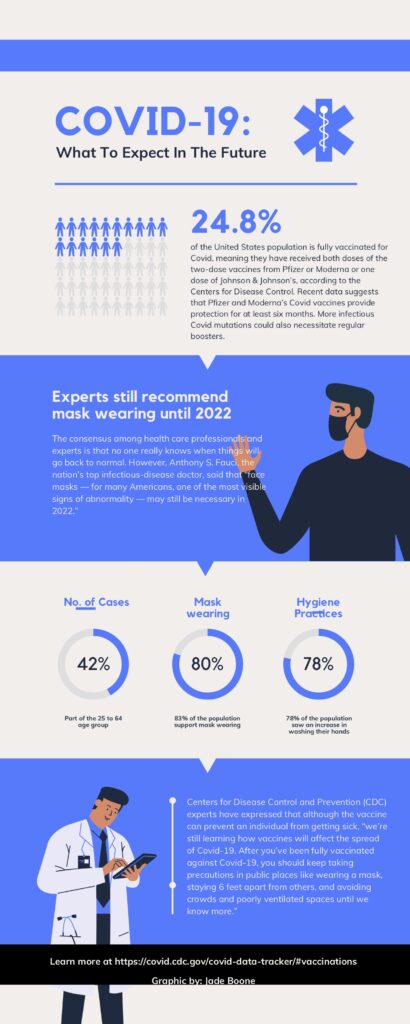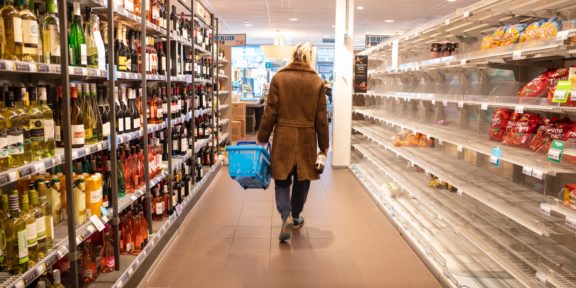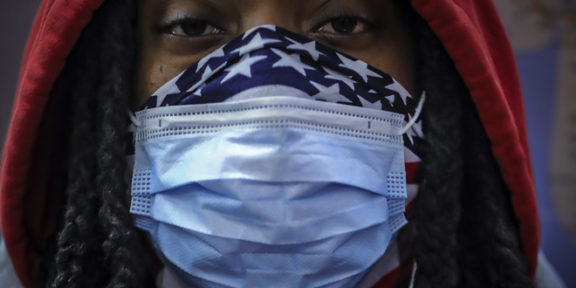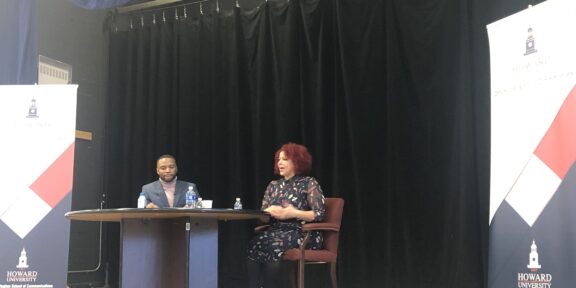Jade Boone, Reimagined Futures for Howard University News Service
The year 2020 brought a worldwide challenge not seen in over a century: a virus that spreads at an unprecedented rate, claiming the lives of many, closing down businesses, and causing the world to rely heavily on health care professionals.
Many headlines that have been made about the Covid-19 pandemic include “going back to normal”, but what exactly is the new normal health wise and what will change?
According to Dr. Sunhil Joshi, president of the Duval County Medical Society Foundation in an interview with News4Jax stated, the covid vaccine will become a routine for citizens every fall or winter. “We may need a booster this fall or the upcoming winter, and we’ll potentially have a seasonal vaccine after that,” Joshi said.
In the U.S., 84.5 million adults have been fully vaccinated, with 217 million receiving at least one shot. Pfizer CEO Albert Bourla said people will “likely” need a booster dose of a Covid-19 vaccine within 12 months of getting fully vaccinated. Bourla said it’s possible people will need to get vaccinated against the coronavirus annually.
As Covid-19 vaccinations are being distributed worldwide, many countries are implementing or considering the use of a “Vaccine passport,” which are digital or paper forms certifying that the person has been vaccinated for Covid-19.
According to the Kaiser Family Foundation (KFF), the U.S. government is exploring COVID-19 vaccine certifications for use internationally and domestically. The administration has said that a vaccine passport may be required in the future for international travelers entering the U.S., but it will not impose a federal requirement for domestic purposes. However, it is working with the private sector to develop standards around such certifications.
With over a year since the pandemic, local governments and public health officials around the world have been exploring measures to help combat and maintain the coronavirus.
 Temperature checks before entering an establishment and sanitation stations, have become part of daily life for millions across the world, among other measures.
Temperature checks before entering an establishment and sanitation stations, have become part of daily life for millions across the world, among other measures.
According to an interview with CNBC, Purell, the inventor of hand sanitizer, is expecting that demand for the cleansing product will remain elevated from pre-coronavirus pandemic levels as the world emerges from the biggest global health crisis in a century.
Several countries including Mexico, have implemented sanitation misters that spray you with a substance designed to kill all bacteria on your clothing and belongings, but experts say those tactics have not proven to be effective.
“The sanitation mist machines and temperature checks won’t help in identifying Covid-19,” said Joshua Michaud, associate director for Global Health Policy at KFF where he helps guide and oversee KFF’s research and analysis in the area of global health. KFF is a nonprofit organization focusing on national health issues, as well as the U.S. role in global health policy.
“There is a lot more that we could be doing. Having public health departments that have resources and staff members. Contact tracing, vaccine distribution, supplies to information technology. These are really important to basic public health.”
Covid-19 has also impacted the workplace.
Companies are reviewing if they should bring employees back into the office. More than 40 Fortune 500 companies have started the process of having employees returning to the office while still practicing social distancing and providing protective gear. On the other hand, some companies such as Franklin Templeton Investments have their employees working from home until further notice to measure out when it is safe to return to office and if all employees will be required to be vaccinated.
Target Corporation is one company that has indicated it will be practicing current measures for the foreseeable future. Chief Executive Brian Cornell told reporters recently.
“The focus on safety will be with consumers for years to come,” he said. “We will continue to lean into ensuring a safe, contact-free environment. The plexiglass will stay up for a while, and we will continue to encourage social distancing.”
Many stores have implemented wiping down the card reader and register after each customer is done using them. These practices are also seen in social settings with a hand sanitizer dispenser at entrances and exits.
Better hygienic practices have also become more of the norm due to the pandemic and might linger after. Early evidence suggests that personal behavioral changes, such as hand-washing and wearing masks, persisting after lock-downs, are helping to slow down the risk of infection. In a June report from a team at the MRC Centre for Global Infectious Disease Analysis at Imperial College London found that among 53 countries beginning to open up, there hasn’t been as large a surge in infections as predicted on the basis of earlier data.
At Anhembi Morumbi University in São Paulo, Brazil, computational biologist Osmar Pinto Neto and colleagues ran more than 250,000 mathematical models of social-distancing strategies alongside the behaviors of hand washing and mask wearing.
The team concluded, “If people exercise caution while in public by protecting themselves (e.g., wearing a facemask, proper hand hygiene and avoid agglomeration) the magnitude and duration of social distancing, necessary to maintain control over the pandemic can be reduced.”
“Our models suggest that the most effective way to reduce SD over a two-year period is a stepping-down approach every 80 days. According to our model, this method would prevent a second peak and the number of intensive care units needed per day would be within the threshold of those currently available.”
The Bradley Corporation released a Healthy Hand Washing Survey, which revealed the majority of Americans are following the CDC hand washing guidelines.
“Ninety percent say they are washing their hands more frequently or more thoroughly or longer and 78 percent are washing their hands six or more times a day. That’s compared to just 37 percent who washed up that often prior to the outbreak. In addition, 77 percent are washing their hands for at least 20 seconds or longer, per CDC recommendations. Prior to the coronavirus, the majority of Americans were not washing their hands long enough. Fifty-seven percent estimated they washed for just five to 15 seconds,” the survey said.
When President Joe Biden was sworn in, his first ask of the country was to follow a 100-day mask mandate. How masks have been viewed in the pandemic has not been uniform, with some backlash against it since last year.
In the US during the Spanish Flu, masks recommendations received backlash, similar to some responses in the current pandemic.
“America never truly adopted mask wearing, maybe that’s a mistake that we didn’t adopt sooner. Masking prevents influenza and spreads the virus at a faster rate,” says Dr. Dean Blumberg, associate professor chief of pediatric infectious diseases at UC Davis Health.
“Unfortunately our collective memory is very fleeting, once we get past a threat or evidence of people dying from a different disease, the behaviors will fall off,” said Michaud. “When you look back in history when a pandemic first happens. There will be a process, we adopt behaviors because of it, but they are temporary behaviors. I’d be surprised if there were long standing mask wearing.”
Dr. John Conly, an infectious disease physician at Canada’s University of Calgary who has also studied masks, says he wouldn’t support masking after the pandemic ends, given downsides like discomfort and difficulty communicating.
“What our life after the pandemic will be like, no one truly knows, but after further testing and research, people are hopeful we’ll be able to gather in large social settings,” Dr. Blumberg said.











